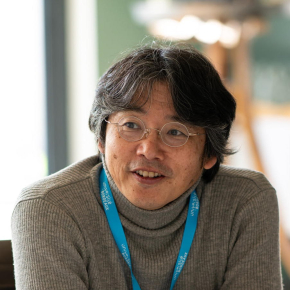CNRS Chemistry welcomes Hiroshi Kageyama as an Ambassador in Chemical Sciences
On January 20th 2025, Hiroshi Kageyama, Professor at the Graduate School of Engineering, Kyoto University, will start a series of lectures in several CNRS laboratories as the Ambassador in Chemical Sciences in France. Professor Kageyama's research activities focus on the synthesis and characterization of novel inorganic materials, particularly mixed anion compounds, which exhibit unique properties due to the presence of multiple anions in their structures. These materials have potential applications in various fields, including superconductivity, magnetism, dielectrics, and catalysis.
What initially sparked your interest for inorganic chemistry and how did it shape your research career?
I am a solid-state chemist by training, though my early research focused on physics, including high-temperature superconductivity and quantum spin systems, primarily using existing materials. Around 2002, I made a drastic shift to solid-state chemistry, aiming to create new compounds and explore their functionalities. My initial work centered on topochemical reactions, such as ion-exchange reactions, which led to important discoveries in transition metal oxydes, like SrFeO₂. Over time, I expanded my research to include various synthetic techniques, such as high-pressure synthesis and thin-film fabrication. My research has increasingly focused on the synthesis of mixed-anion compounds, such as oxyhydrides, and the investigation of their functionalities in areas including magnetism, (photo)catalysis, energy storage, and superconductivity. This career path, spanning both physics and chemistry, has provided me with a wide-ranging perspective on materials, allowing me to bridge diverse scientific concepts and address challenges in material design and application. Collaborating with researchers from diverse backgrounds, including colleagues in France, has further enriched my approach to material synthesis and functional exploration.
How do you expect functional inorganic materials will impact future technologies?
Unlike oxides, mixed-anion compounds provide entirely new dimensions for functionalities in electronics, data storage, and energy. Their ability to incorporate various anions, such as oxides, hydrides, halides, and nitrides, allows the creation of materials with tailored properties that are not achievable with conventional oxides, making them highly promising for advanced technologies. For instance, incorporating hydride (H–) anions into oxide structures imparts catalytic activity. In photocatalysis, layered oxyhalides show great potential for visible-light-driven reactions. Our recent research highlights band engineering with multiple anions, a key feature in photocatalytic water splitting. Additionally, perovskite oxyfluorides are emerging as candidates for fluoride-ion batteries, offering higher energy density and stability. The field of mixed-anion compounds is rapidly advancing, and the research community is increasingly focused on this promising area. As these materials continue to evolve, their applications will likely revolutionize key industries in energy, electronics, and catalysis, with growing interest from both academia and industry.
As a CNRS ambassador of Chemical Sciences, what are you most looking forward to during your French conference tour?
I am excited about the opportunity to expand the international network during my French conference tour. I look forward to engaging with researchers from various fields to discuss mixed-anion compounds, which represent a promising frontier in materials science. These compounds require a deeper understanding of chemistry, as well as the ability to predict material properties using information and uncover unknown physics, offering new possibilities for applications. In particular, ceramics containing molecular anions, which we call "supra-ceramics," are an exciting extension of this research. Through interactions with researchers from diverse disciplines, I aim to encourage new collaborations and uncover fresh possibilities for both fundamental and applied research. A key part of this effort is the ASPIRE project on mixed-anion compounds, approved by the Japan Science and Technology Agency in December 2024, which will continue until 2030. This international collaboration involves researchers from six countries, including France, with universities in Nantes, Rennes, Bordeaux, and Lille, and I hope to further extend the project by involving additional institutions.
Editor: AVR
Hiroshi Kageyama's Lectures Tour
- 20-22/01/2025 - Bordeaux - Institut de chimie de la matière condensée de Bordeaux (Cyril Aymonier/Alain Demourgues)
- 23/01/2025 - Paris - Laboratoire de chimie de la matière condensée de Paris (David Portehault)
- 24/01/2025 - Caen - Laboratoire de cristallographie et sciences des matériaux (Wilfrid Prellier)
- 27-29/01/2025 - Lille - Unité de Catalyse et de Chimie du Solide (Olivier Mentre)
- 30/01/2025 - Amiens - Laboratoire de réactivité et chimie des solides (Christian Masquelier)
